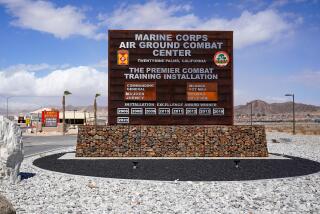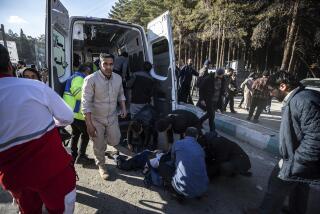Afghan insider’s killing of U.S. general marks grim renewal of tactic
- Share via
Reporting from Washington — A gunman believed to be an Afghan soldier opened fire Tuesday at a military academy in Kabul, killing a U.S. Army major general and wounding 14 others in one of the bloodiest fratricidal attacks of the 13-year war in Afghanistan.
The shooter, who was wearing an Afghan army uniform, wounded a German brigadier general and three Afghan officers before he was killed, officials said. Eight of the casualties were U.S. troops, senior Pentagon officials said.
Army Maj. Gen. Harold J. Greene, 55, the deputy commander responsible for training Afghan troops, was killed during what U.S. officials said was a routine site visit by coalition officers to Marshal Fahim National Defense University, an elite facility U.S. officials described as Afghanistan’s version of West Point.
Greene, who had a doctorate in materials science from USC, was on his first combat tour in Afghanistan after a lengthy Army career as an engineer and logistics expert. He is believed to be the highest-ranking U.S. officer killed overseas since the Vietnam War.
“It’s a terrible day. It’s a terrible tragedy,” Rear Adm. John Kirby, the Pentagon spokesman, told reporters.
The high-profile assault represents a grim renewal of the insider attacks by Afghans that killed dozens of Americans and other coalition troops two years ago. It is likely to prompt stricter security measures to protect the approximately 30,000 Americans, as well as other foreign troops, who remain in Afghanistan. Most of them are to be withdrawn by the end of the year.
Kirby said the U.S. and its allies faced a “pernicious threat” from disaffected Afghan troops that was impossible to eliminate, despite strict vetting of Afghan soldiers and other security measures adopted since 2013.
The shooting is also likely to focus new attention on the Obama administration’s plan to keep 9,800 U.S. troops in Afghanistan after this year. Many would work closely with Afghan counterparts at training facilities in Kabul and on major military installations around the country.
The plan has been on hold since last year because of Afghan President Hamid Karzai’s refusal to sign a bilateral security agreement laying out terms of the U.S. presence, including a U.S. demand that American troops be given immunity from prosecution under Afghan laws. U.S. officials are awaiting the outcome of the country’s disputed president election, hoping Karzai’s successor will sign the agreement.
The Pentagon initially withheld Greene’s name, citing a policy of waiting 24 hours after relatives are notified. But officials confirmed his identity after numerous news outlets published and broadcast his name. Germany’s military confirmed that one of its brigadier generals was among those wounded. The injuries were not life-threatening.
Kirby said the gunman was not a “very high-ranking Afghan soldier.” But officials released few details about the midday attack, including the attacker’s motive or how he was able to shoot a senior U.S. officer, who would typically be protected by security details with a mission to look out for just such a threat. The attacker was not immediately identified.
Kirby said officials from Afghanistan and the International Security Assistance Force, the NATO-led force that is commanded by a U.S. general, had begun a joint investigation.
Gen. Ray Odierno, the Army chief of staff, said in a statement that the Army was focused on helping Greene’s family and the families of the wounded. “Our priority right now is to take care of the families, ensuring they have all the resources they need during this critical time,” he said.
President Obama called Marine Gen. Joseph F. Dunford Jr., the top commander in Afghanistan, for a briefing on the shooting, according to Josh Earnest, the White House press secretary.
“Today’s tragic incident is a painful reminder that our servicemen and women are still serving and sacrificing in Afghanistan,” Earnest said. “And they’re facing significant risks to protect our country and to protect American citizens all around the globe.”
In a statement, Karzai condemned the attack as cowardly, calling it “an act by the enemies who don’t want to see Afghanistan have strong institutions.”
A spokesman for the Taliban insurgency, Zabiullah Mujahid, praised the “honorable Afghan soldier” who carried out the attack. But he did not assert that Taliban commanders had planned it, and he got some of the details wrong, saying the gunman “killed one Italian and three U.S. generals,” along with several others.
The military academy is in the Qargha district, on the west side of Kabul, the capital. Afghan officer candidates receive instruction in academic subjects, as well as in tactics and other military skills before they receive commissions and are assigned to units in the field.
A separate facility for training Afghanistan’s noncommissioned officers is nearby.
It was unclear if the gunman was a student or teacher at the academy, was assigned to guard the visiting delegation of Afghan and foreign military officers, or was traveling with them.
Greene, a native of upstate New York, joined the Army as an engineer in 1980 after graduating from Rensselaer Polytechnic Institute in Troy, N.Y. He earned master’s degrees from Rensselaer and USC in addition to his PhD, according to an official Army biography.
In January, he was assigned deputy commander of Combined Security Transition Command Afghanistan, the U.S.-led command that oversees the training of the Afghan military. He had previously completed tours in Germany, Turkey and Greece, though his official biography does not list previous tours in combat zones.
He was living in Falls Church, Va., a suburb of Washington, with his wife, a retired Army colonel, when he was assigned to Afghanistan.
Greene “wanted to be in Afghanistan,” according to a Defense official familiar with him. Greene told a colleague in March “how happy he was to be over there” working directly with soldiers and Afghan troops, the official said.
His job helping the Afghan military improve training and logistics is not glamorous but is considered vital to the future of the still-fledgling Afghan military, the official said. “He was a key figure in helping the Afghan forces develop their skills in logistics,” the official said.
Greene is the highest-ranking U.S. military officer killed since an Army lieutenant general was killed when Al Qaeda terrorists flew a hijacked airliner into the Pentagon during the Sept. 11, 2001, attacks.
david.cloud@latimes.com
More to Read
Sign up for Essential California
The most important California stories and recommendations in your inbox every morning.
You may occasionally receive promotional content from the Los Angeles Times.














